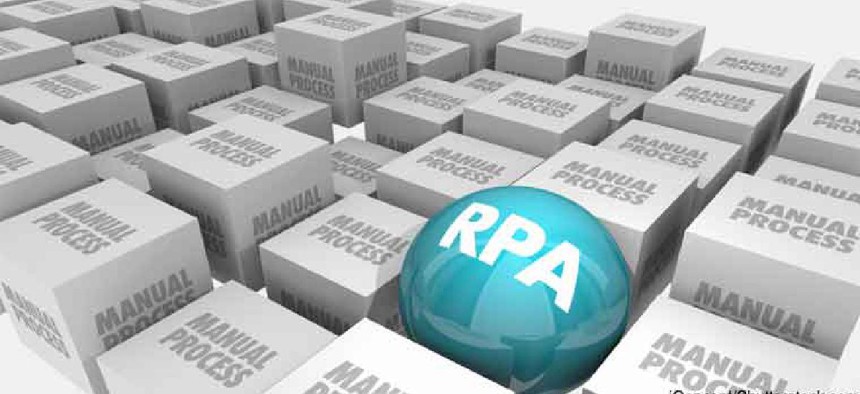With RPA, Ginnie Mae simplifies complex processes

Robotic process automation has helped the mortgage securities guarantor reduce the amount of time employees spend on manual tasks and limit potential errors.
For the past year, Ginnie Mae has been using robotic process automation (RPA) to reduce the amount of time employees spend on manual tasks and limit potential errors.
Ginnie Mae -- the Government National Mortgage Association, a government-owned corporation within the Department of Housing and Urban Development -- has put three bots into production. One, called DABO, collects and organizes data related to the London Inter-bank Offered Rate (LIBOR), the principal index for most adjustable rate mortgage-backed securities, and the Treasury Department’s CMT rates, which represents the one-year yield on Treasury securities.
DABO replaced the manual process to determine adjustable mortgage (ARM) rates. Previously an employee used a calendar and counted back 30 or 45 days, depending on the need, taking holidays into account, then logging into the Wall Street Journal website to find out the closing rates for that particular date, said Chastity Abrom, senior business analyst at Ginnie Mae’s Office of Securities Operations (OSO).
Now, the bot automatically checks the website daily in accordance with Ginnie Mae’s guide on mortgage-backed securities and records the ARM rate, the closing rates for Treasury CMT and LIBOR. It builds a historical table and record so that when a Ginnie Mae employee needs the 45- and 30-day lookback rate, the information is on hand.
“We looked at automating that process because it just seemed very simple,” Abrom said. Because there are very few exceptions to the “very binary process -- it’s either yes or no -- we figured that would be the simplest process for us to automate,” she said.
Another bot, dubbed RBG, after late Supreme Court Justice Ruth Bader Ginsburg, helps employees of the Office of the Chief Financial Officer (OCFO) manage and report key commitment authority reconciliation information to the Ginnie Mae general ledger.
Previously OCFO budget analysts had to log into external systems, download several reports, format them and then upload them into the Ginnie Mae system. It took about three hours for three workers each day to do this manually, but it takes less than one hour for the bot process, said Naiqi (Sherry) Morrison, chief architect at Ginnie Mae.
“The bot performs 99 manual process steps in a few minutes -- whereas staff members take two to three hours to perform them,” according to Ginnie Mae’s 2020 progress update.
OSO is also using RBG to assist with commitment authority reconciliation, replacing a process that previously took 38 steps, Abrom said.
“It was such a time-consuming daily process,” Abrom said. “It was taking our specialists 45 minutes to an hour every single day to complete this process … of comparing reports, comparing spreadsheets, comparing data, finding out what had gone from a pending status to an approved status, so we figured, ‘Hey, this is a prime target for RPA.’”
To prepare, OSO first streamlined the process to 21 steps before automating it. Now, it takes less than two minutes to complete -- and with far less room for error.
“That many steps in the raw process makes it error-prone,” Abrom said. “One of the greatest benefits we’re receiving from RBG is accuracy.”
Lastly, Bot Pioneer handles planning and budget data management processes for salaries and expenses analysis involving multiple external sources.
Research into using RPA at Ginnie Mae began in 2018. Lessons learned from experience include getting support from leadership and involving all stakeholders early.
“Get the C-suite buy-in,” Morrison said. “Get both IT and business together in the early stage. That’s actually a very good experience for us. That makes these emerging technologies adoptions so much smoother.”
From the business side, Abrom recommended investing the time to understand and map the process and how it fits into overall operations.
“Focus on making sure you understand the requirements, making sure you understand the business process and just spend a lot of time and effort on the process mapping before you even get to the automation phase,” she said.
Part of a larger IT modernization effort at Ginnie Mae, RPA is likely to find more opportunities within the organization. “The agency intends to expand the number of RPA processes deployed and implement more sophisticated [artificial intelligence] functions, such as machine learning, where appropriate,” according to agency officials.
“It’s all about making the operations process more efficient, improving data quality and increasing employee job satisfaction” Morrison said.





